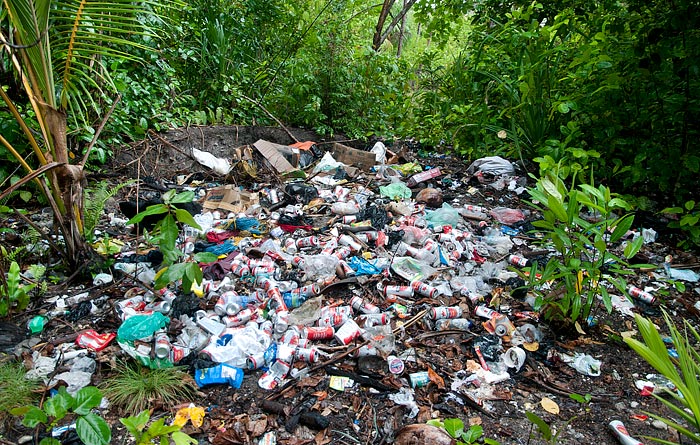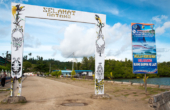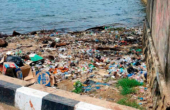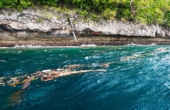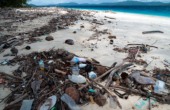Over the last few years there’s been a noticeable increase in the amount of trash in Raja Ampat waters. It’s a concern for all and it’s worth considering the following facts when discussing it:
- An overwhelming majority of the rubbish does not originate in the islands themselves.
- Local people are every bit as aware of and concerned by the issue as visitors.
- The piles of trash that can be seen near some homestays are the product of guest consumption and beach cleanups. They remain there because…
- As in most of Indonesia, there is no effective waste management system in place to deal with the rubbish being generated by ever increasing numbers of visitors and immigrants.
- If you want to ensure none of your own waste contributes to the rubbishing of Raja Ampat, you have to take it with you when you leave.
Raja Ampat Trash: Non-local origin
The vast majority of rubbish appearing in Raja Ampat waters has its origin in the growing settlements of Sorong and Waisai.
While improvements to local practices can always be made, it’s obvious that the recent increase in the volume of trash appearing in Raja Ampat closely parallels the explosive growth of Sorong and Waisai, as well as that of the tourism industry itself. Other significant contributors are Indonesia’s large inter-island Pelni passenger ships and fishing boats who continue the deplorable practice of disposing of all their waste at sea. Some liveaboard dive boats are also guilty of dumping trash in the islands.
Raja Ampat’s location and Pacific Ocean currents also make the islands a trap for waste generated by population growth and poor waste management practices much further afield. We’ve seen plastic waste on Raja Ampat beaches that originated in the Philippines and one container that rode the southern equatorial current all the way from Mexico!
Domestic tourism
Unfortunately, it’s been our experience that many Indonesian domestic tourists and tourism operators don’t seem to be aware of the importance of keeping Raja Ampat clean.
It’s so disappointing to see people marvelling at beautiful views, then wedging empty cigarette packets, water bottles and snack wrappers into trees around the viewpoint before returning to their tour boats. Despite the signs on ferries and at Waisai harbour imploring people not to throw rubbish into the sea, standing at the stern of the Sorong-Waisai ferry and watching the constant stream of small items being tossed overboard shows that signs alone are obviously not enough to change these thoughtless habits.
It’s sad too, to see domestic tour operators arrive on remote islands, distribute plastic instant meal trays and water cups to their guests for lunch, and then depart – leaving all that waste on an island with no means of disposing of it. Those operators are returning to Waisai or Sorong. Surely it’s not too difficult to take their rubbish with them?
Neither of those sights though, create the frustration experienced when sitting in a boat with western tourists on their way to a dive, listening to one of their number criticise Indonesian people for not caring about their environment and then flicking his cigarette butt over the side of the boat. When challenged on his hypocrisy his answer was “It’s only a cigarette butt, not plastic.” So many kinds of wrong!
Local concern
It’s also wrong to think that the majority of Raja Ampat islanders need to be educated about correct waste management practices. Local people have grown up in a pristine environment and are every bit as concerned about the amount of trash showing up around their villages as visitors are. This is especially true of homestay owners and local tourism operators, who are well aware of the negative impact on their businesses from trash in the environment.
This natural propensity to want to live in a clean environment has been further reinforced and supported by programs like Conservation International’s Kalabia floating classroom project, which stresses to children the importance of correct disposal of modern non-biodegradable waste. You can see a great video about the Kalabia project on our Raja Ampat conservation programs page. Other local initiatives are also working on solutions and are worth supporting.
The Raja Ampat Homestay Association places a high priority on the importance of rubbish collection and disposal and conscientious members are already doing all they can to keep their local environment rubbish free.
Assessment of member compliance with this requirement is one of the criteria examined in Association membership reviews and most homestays do their best to maintain an environment free of rubbish. The major issue they face in doing so is…
Lack of effective waste management planning
As in most of Indonesia, Raja Ampat has no effective waste management facilities or plan. This is a consequence of Indonesia’s rapid modernisation and adoption of the consumer lifestyle: Barely two generations ago all waste generated in Indonesian society was biodegradable.
In towns where rubbish collection services do exist, they are often provided by scavengers who salvage items with an immediate resale value and dispose of the rest in the nearest available river, drain or unoccupied patch of land. Even if landfill sites are available, they are often poorly managed and a source of pollution themselves.
Faced with this reality, the villagers and homestay owners out in the islands have the problem of what to do with non-biodegradable rubbish. Those who make the effort to remove trash from their environment are left with no alternative but to arrange local disposal by burning and burying. For the foreseeable future, whatever is taken to (or washes up on) the islands of Raja Ampat will remain there. Which means…
Don’t rubbish Raja Ampat – if you bring it in, take it out!
Given the above, it’s clear that there’s only one way to be sure you won’t contribute to the problem: Take all the non-biodegradable waste you generate away with you when you leave.
Please note that disposing of trash in a rubbish bin in Waisai or Sorong is no guarantee that it won’t wind up polluting the ocean.
To minimise the amount of luggage space devoted to packing out your trash, you might want to also consider the following –
- Don’t buy bottled water. Bring a refillable container for your drinking water. All homestays provide safe drinking water – you can read more about homestay drinking water here.
- Avoid purchasing other products packaged in plastic. If you want to take plastic packaged foods out to the islands, buy them somewhere there’s adequate disposal facilities and pack them in airtight reusable containers for transport. (Doing so will also protect your snacks from the predations of hungry local critters – a plastic bag’s no obstacle to a determined native rat!)
- If you need batteries for devices, bring rechargeable ones. (There’s no safe way to dispose of dead batteries in Raja Ampat.)
Pitch in and help
You can also help out in the following ways –
- Set a good example: If you spot trash lying around, collect it and ask your host about disposal.
- Join the team: Jump in and lend a hand when you see a clean up team at work.
- Clean up underwater: Plastic on the reef is much more damaging than the stuff on the beach. If you see small items of plastic trash while diving, grab them and store them in your BCD pocket for later disposal. Always ensure you remain within your depth limit and that your bouyancy control is good enough to permit retrieval without reef damage though!
